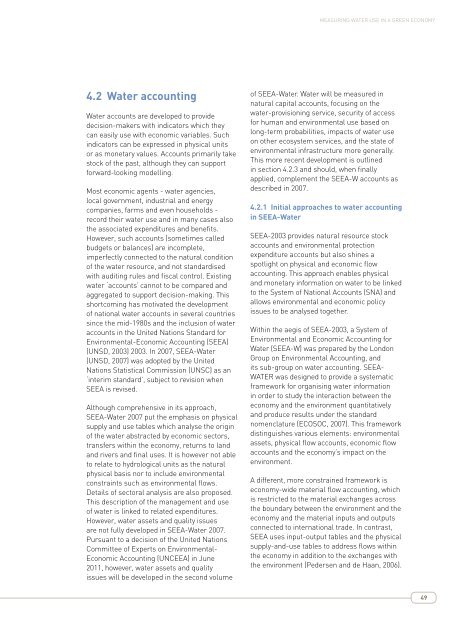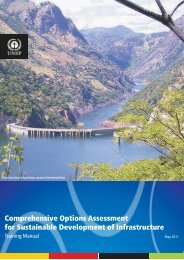MEASURING WATER USE IN A GREEN ECONOMY - UNEP
MEASURING WATER USE IN A GREEN ECONOMY - UNEP
MEASURING WATER USE IN A GREEN ECONOMY - UNEP
You also want an ePaper? Increase the reach of your titles
YUMPU automatically turns print PDFs into web optimized ePapers that Google loves.
Measuring water use in a green economy<br />
4.2 Water accounting<br />
Water accounts are developed to provide<br />
decision-makers with indicators which they<br />
can easily use with economic variables. Such<br />
indicators can be expressed in physical units<br />
or as monetary values. Accounts primarily take<br />
stock of the past, although they can support<br />
forward-looking modelling.<br />
Most economic agents - water agencies,<br />
local government, industrial and energy<br />
companies, farms and even households -<br />
record their water use and in many cases also<br />
the associated expenditures and benefits.<br />
However, such accounts (sometimes called<br />
budgets or balances) are incomplete,<br />
imperfectly connected to the natural condition<br />
of the water resource, and not standardised<br />
with auditing rules and fiscal control. Existing<br />
water ‘accounts’ cannot to be compared and<br />
aggregated to support decision-making. This<br />
shortcoming has motivated the development<br />
of national water accounts in several countries<br />
since the mid-1980s and the inclusion of water<br />
accounts in the United Nations Standard for<br />
Environmental-Economic Accounting (SEEA)<br />
(UNSD, 2003) 2003. In 2007, SEEA-Water<br />
(UNSD, 2007) was adopted by the United<br />
Nations Statistical Commission (UNSC) as an<br />
‘interim standard’, subject to revision when<br />
SEEA is revised.<br />
Although comprehensive in its approach,<br />
SEEA-Water 2007 put the emphasis on physical<br />
supply and use tables which analyse the origin<br />
of the water abstracted by economic sectors,<br />
transfers within the economy, returns to land<br />
and rivers and final uses. It is however not able<br />
to relate to hydrological units as the natural<br />
physical basis nor to include environmental<br />
constraints such as environmental flows.<br />
Details of sectoral analysis are also proposed.<br />
This description of the management and use<br />
of water is linked to related expenditures.<br />
However, water assets and quality issues<br />
are not fully developed in SEEA-Water 2007.<br />
Pursuant to a decision of the United Nations<br />
Committee of Experts on Environmental-<br />
Economic Accounting (UNCEEA) in June<br />
2011, however, water assets and quality<br />
issues will be developed in the second volume<br />
of SEEA-Water. Water will be measured in<br />
natural capital accounts, focusing on the<br />
water-provisioning service, security of access<br />
for human and environmental use based on<br />
long-term probabilities, impacts of water use<br />
on other ecosystem services, and the state of<br />
environmental infrastructure more generally.<br />
This more recent development is outlined<br />
in section 4.2.3 and should, when finally<br />
applied, complement the SEEA-W accounts as<br />
described in 2007.<br />
4.2.1 Initial approaches to water accounting<br />
in SEEA-Water<br />
SEEA-2003 provides natural resource stock<br />
accounts and environmental protection<br />
expenditure accounts but also shines a<br />
spotlight on physical and economic flow<br />
accounting. This approach enables physical<br />
and monetary information on water to be linked<br />
to the System of National Accounts (SNA) and<br />
allows environmental and economic policy<br />
issues to be analysed together.<br />
Within the aegis of SEEA-2003, a System of<br />
Environmental and Economic Accounting for<br />
Water (SEEA-W) was prepared by the London<br />
Group on Environmental Accounting, and<br />
its sub-group on water accounting. SEEA-<br />
<strong>WATER</strong> was designed to provide a systematic<br />
framework for organising water information<br />
in order to study the interaction between the<br />
economy and the environment quantitatively<br />
and produce results under the standard<br />
nomenclature (ECOSOC, 2007). This framework<br />
distinguishes various elements: environmental<br />
assets, physical flow accounts, economic flow<br />
accounts and the economy’s impact on the<br />
environment.<br />
A different, more constrained framework is<br />
economy-wide material flow accounting, which<br />
is restricted to the material exchanges across<br />
the boundary between the environment and the<br />
economy and the material inputs and outputs<br />
connected to international trade. In contrast,<br />
SEEA uses input-output tables and the physical<br />
supply-and-use tables to address flows within<br />
the economy in addition to the exchanges with<br />
the environment (Pedersen and de Haan, 2006).<br />
49

















